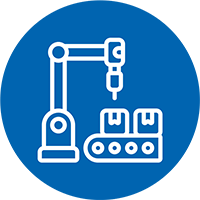COLOR
COLOUR SEPARATION DURING PCB PROCESSING
PRINTED CIRCUIT BOARDS (PCB) ARE USED TO LOCATE THE VARIOUS ELEMENTS that make up a circuit and the electrical interconnections between them. Most PCBs contain a variety of strategic metals, such as precious metals (gold, silver, palladium and platinum), and base metals (nickel, copper, aluminium, zinc, tin, lead and iron). During decontamination of WEEE material, tonnes of PCBs are generated and sent out of the country for disposal. The Basque Country alone consumes more than 472,000 tonnes per year of main non-ferrous metals such as aluminium, copper, nickel, molybdenum, chrome, zinc and tin, worth EUR 1,420 million per year.
REYDESA, part of the Otua Group, is a leading company in the recovery of ferrous and non-ferrous metals that manages a wide range of metal waste. For the COLOR project implementation, the company worked with INATEC, the Otua Group’s R&D Unit. Since 2016, it has conducted several research projects in the search of copper and precious metal extractive processes, with the aim of defining a treatment process for these materials, and has recently acquired optical separation technology to be used in other processes, potentially applicable to the treatment of PCBs.

DRIVING FACTOR


 OBJECTIVES
OBJECTIVES
- Carry out industrial tests that demonstrate the technical, economic and environmental feasibility of a technology based on optical sensors applied to the material resulting from PCB treatment throughout their mechanical processing, in order to recover the strategic metals contained in PCBs.
- Reduce the flow of PCBs managed outside the country, to recover strategic metals within the Basque Country and improve the results of WEEE recovery.
- Reduce hazardous gases and effluents generated during traditional treatments, through a new, more environmentally friendly process.
- Compare this new technique with the current treatment of PCBs.
 RESULTS
RESULTS
- Low separation efficiencies by replacing the traditional density separation treatment in mechanical treatment by separation with the new technology. The colouring of particles that form part of the material is not always a sign of metallic content and as a consequence, the desired metallic content cannot be concentrated in the fractions segregated by colour. This defines the new sensor-based colour separation method as not technically feasible to concentrate metal contained in crushed PCBs.
- Improvement of the quality of the metal concentrate obtained by implementing the new technology after the density separation treatment: good separation performance in this case as the metal fraction has less variety of colours, facilitating adequate separation, as a result.
- Savings of 159.7 kg of CO2e emissions per tonne of PCB treated using the traditional mechanical treatment scheme and incorporating the new technology at the end of the process to improve the quality of the separated metal concentrate.
- Environmental improvement of 19.3% in aggregate impact potential (Pt) values, compared to pyrometallurgical treatment, considering the traditional mechanical treatment and incorporating the new technology at the end of the process.
 CONCLUSIONS
CONCLUSIONS
- The low concentration of strategic metals within separated metal concentrate means there is loss of metal material in the reject as part of plastic parts. Possible solutions include further grinding or introducing a different type of detector capable of detecting metal-containing parts to improve separation performance.
- The interference of debris on materials may require a pre-cleaning step, which consumes water and produces effluents.
- The new technology is considered a part of the mechanical treatment to improve the quality of metal concentrate, but not a replacement for the traditional density separation treatment.
ENVIRONMENTAL
TECHNICAL
ECONOMIC
COMMERCIAL
ON THE MARKET


